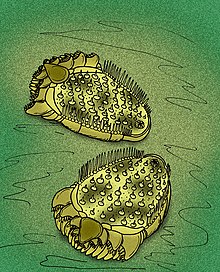Ctenoimbricata
| Ctenoimbricata Temporal range: | |
|---|---|

| |
| Artist's restoration | |
| Scientific classification | |
| Domain: | Eukaryota |
| Kingdom: | Animalia |
| Superphylum: | Deuterostomia |
| Clade: | Ambulacraria |
| Phylum: | Echinodermata |
| Genus: | †Ctenoimbricata Zamora, Rahman, and Smith 2012 |
| Type species | |
| Ctenoimbricata spinosa Zamora, Rahman, and Smith 2012 | |
Ctenoimbricata is an extinct genus of bilaterally symmetrical echinoderm, which lived during the early Middle Cambrian period of what is now Spain.[1] It contains one species, Ctenoimbricata spinosa. It may be the most basal known echinoderm. It resembles the extinct ctenocystoids and cinctans, particularly the basal ctenocystoid Courtessolea. Ctenoimbricata is interpreted as a deposit-feeding pharyngeal basket feeder. It was relatively small, with a body 20 millimetres (0.79 in) long.
References
- ^ Zamora, Samuel; Rahman, Imran A.; Smith, Andrew B. (2012-06-06). "Plated Cambrian bilaterians reveal the earliest stages of echinoderm evolution". PLoS ONE. 7 (6). Keith A. Crandall (ed.): –38296. doi:10.1371/journal.pone.0038296. ISSN 1932-6203. PMC 3368939.
